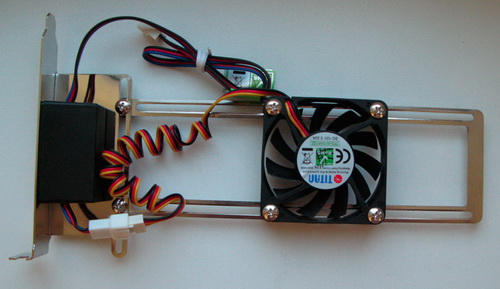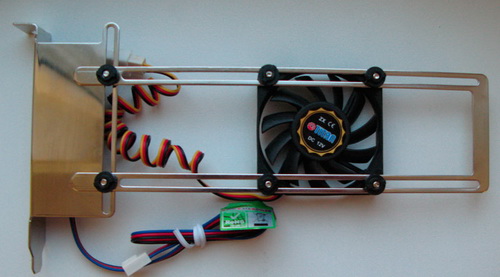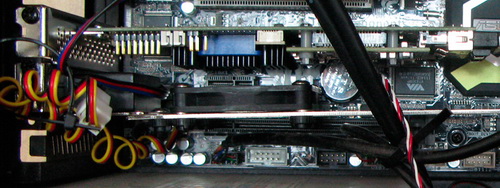Cooling hardware RAID controller in the desktop package
A part of RAID controllers, though not equipped with active cooling, does require it, which is usually clearly indicated in the instructions. For example, Adaptec 6805 has the following limitations *: 55 ° without a ZMM ** module, 50 ° with the ZMM module installed. In server cases, there are no problems with cooling such controllers, and the processors can also be equipped only with a radiator, and a powerful air flow for cooling is generated by case fans. In the desktop, problems can start ...
Unfortunately, in the case of a system assembly in the desktop package, the cooling of the RAID controller is often forgotten. As a result, its temperature quickly rolls over admissible limits and glitches can begin: disks fall off, arrays disappear, the system hangs, etc. In this case, they usually sin on disks, drivers, firmware ... In some cases, it is not prudent to forget about cooling, but they somehow make it not quite right. I came across options with screwing a suitable-sized fan to the radiator, as well as hanging the fan on the screeds. In the first version, difficulties may arise with the selection and fastening of a suitable fan, and bye-bye warranty. Agree that the loss of a warranty for a device costing 20,000 rubles is not very reasonable. In the second variant, it is necessary to be able to firmly fix the fan so that it does not hang out and does not catch on anything.
There is a more beautiful and convenient solution to the problem with the help of cooling systems for video adapters installed under them in the expansion slot. They cannot cope with the cooling of video cards that the standard system has failed or cannot cope with (if only the simplest ones), but they are often suitable for cooling various expansion cards that overheat.
')


For myself, I chose (or rather took what was just available in the nearest store) the cooling system shown above. Its advantages include adjustment of the speed, the interchangeability of the fan, its convenient positioning under the cooled element. By cons - takes 2 expansion slots. A plus or a minus may be the lack of fixation in the slot on the motherboard. On the one hand, the cooling system can be installed regardless of the type of expansion slot (and its presence) under the card being cooled, on the other hand, the design is not very rigid.

This is how the cooling Adaptec 6805 with ZMM. The temperature of the controller is 32-34 ° (against more than 70 ° without it). Now the case has been moved to a hotter place (next to the compressor of the refrigerator) and the temperature has risen to 35-38 ° , which is still significantly lower than the maximum allowed.
UPD: It is worth noting that the original Adaptec Fan Kit (2275100-R) also exists for the ASR-6xxx series controllers, but its price exceeds all reasonable limits.
PS This is my first post here. Please do not judge strictly. I understand that I wrote quite obvious things, I just ran into the fact that they are often forgotten about them.
___________________________
* - Adaptec's requirements are a bit strange - restrictions are set not on the temperature of the chip itself, but on the temperature inches from it (2.54 cm). Strange, because with the same air temperature near the chip, you can have completely different temperatures of him and other map elements, so I prefer to ensure that the readings of the built-in temperature sensor are not above the mentioned limitations to avoid problems.
** - Zero Maintenance Module. A module based on a flash memory powered by a super-capacitor, designed to save the contents of the controller cache to non-volatile memory in the event of a power failure. After power is restored, the data from the flash memory is copied back to the controller cache. The super-capacitor charges in a few minutes, allowing the ZMM to quickly return to service to protect data.
Unfortunately, in the case of a system assembly in the desktop package, the cooling of the RAID controller is often forgotten. As a result, its temperature quickly rolls over admissible limits and glitches can begin: disks fall off, arrays disappear, the system hangs, etc. In this case, they usually sin on disks, drivers, firmware ... In some cases, it is not prudent to forget about cooling, but they somehow make it not quite right. I came across options with screwing a suitable-sized fan to the radiator, as well as hanging the fan on the screeds. In the first version, difficulties may arise with the selection and fastening of a suitable fan, and bye-bye warranty. Agree that the loss of a warranty for a device costing 20,000 rubles is not very reasonable. In the second variant, it is necessary to be able to firmly fix the fan so that it does not hang out and does not catch on anything.
There is a more beautiful and convenient solution to the problem with the help of cooling systems for video adapters installed under them in the expansion slot. They cannot cope with the cooling of video cards that the standard system has failed or cannot cope with (if only the simplest ones), but they are often suitable for cooling various expansion cards that overheat.
')


For myself, I chose (or rather took what was just available in the nearest store) the cooling system shown above. Its advantages include adjustment of the speed, the interchangeability of the fan, its convenient positioning under the cooled element. By cons - takes 2 expansion slots. A plus or a minus may be the lack of fixation in the slot on the motherboard. On the one hand, the cooling system can be installed regardless of the type of expansion slot (and its presence) under the card being cooled, on the other hand, the design is not very rigid.

This is how the cooling Adaptec 6805 with ZMM. The temperature of the controller is 32-34 ° (against more than 70 ° without it). Now the case has been moved to a hotter place (next to the compressor of the refrigerator) and the temperature has risen to 35-38 ° , which is still significantly lower than the maximum allowed.
UPD: It is worth noting that the original Adaptec Fan Kit (2275100-R) also exists for the ASR-6xxx series controllers, but its price exceeds all reasonable limits.
PS This is my first post here. Please do not judge strictly. I understand that I wrote quite obvious things, I just ran into the fact that they are often forgotten about them.
___________________________
* - Adaptec's requirements are a bit strange - restrictions are set not on the temperature of the chip itself, but on the temperature inches from it (2.54 cm). Strange, because with the same air temperature near the chip, you can have completely different temperatures of him and other map elements, so I prefer to ensure that the readings of the built-in temperature sensor are not above the mentioned limitations to avoid problems.
** - Zero Maintenance Module. A module based on a flash memory powered by a super-capacitor, designed to save the contents of the controller cache to non-volatile memory in the event of a power failure. After power is restored, the data from the flash memory is copied back to the controller cache. The super-capacitor charges in a few minutes, allowing the ZMM to quickly return to service to protect data.
Source: https://habr.com/ru/post/161367/
All Articles